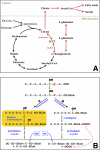Metabolomics, pathway regulation, and pathway discovery
- PMID: 21566142
- PMCID: PMC3129142
- DOI: 10.1074/jbc.R110.171405
Metabolomics, pathway regulation, and pathway discovery
Abstract
Metabolomics is a data-based research strategy, the aims of which are to identify biomarker pictures of metabolic systems and metabolic perturbations and to formulate hypotheses to be tested. It involves the assay by mass spectrometry or NMR of many metabolites present in the biological system investigated. In this minireview, we outline studies in which metabolomics led to useful biomarkers of metabolic processes. We also illustrate how the discovery potential of metabolomics is enhanced by associating it with stable isotopic techniques.
Figures




References
-
- Kell D. B., Oliver S. G. (2004) BioEssays 26, 99–105 - PubMed
-
- Gavaghan C. L., Holmes E., Lenz E., Wilson I. D., Nicholson J. K. (2000) FEBS Lett. 484, 169–174 - PubMed
-
- Griffin J. L., Walker L. A., Garrod S., Holmes E., Shore R. F., Nicholson J. K. (2000) Comp. Biochem. Physiol. B Biochem. Mol. Biol. 127, 357–367 - PubMed
-
- Nicholls A. W., Holmes E., Lindon J. C., Shockcor J. P., Farrant R. D., Haselden J. N., Damment S. J., Waterfield C. J., Nicholson J. K. (2001) Chem. Res. Toxicol. 14, 975–987 - PubMed
-
- Nicholson J. K., Lindon J. C., Holmes E. (1999) Xenobiotica 29, 1181–1189 - PubMed
Publication types
MeSH terms
Substances
Grants and funding
LinkOut - more resources
Full Text Sources

